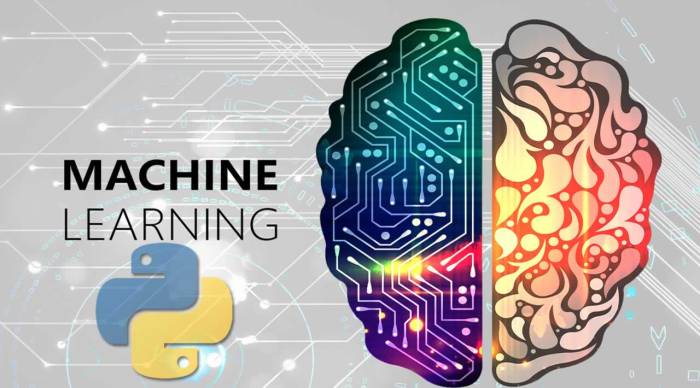Step into the world of AI with Machine learning programming with Python at the helm, where innovation meets simplicity and possibilities are endless. Get ready to dive into a realm where data and algorithms intertwine to create the future.
Exploring the significance of Python in machine learning, the advantages it offers, and the plethora of libraries waiting to be explored, this journey promises to be both enlightening and exciting.
Machine Learning Programming with Python
Python has become one of the most popular programming languages for machine learning due to its simplicity, readability, and flexibility. Its extensive libraries and frameworks make it a preferred choice for data scientists and machine learning engineers.
Advantages of Using Python for Machine Learning
- Easy to Learn and Use: Python’s syntax is clear and concise, making it accessible for beginners and experts alike.
- Extensive Libraries: Python offers a wide range of libraries such as NumPy, Pandas, and Scikit-learn, which provide powerful tools for data manipulation, analysis, and machine learning algorithms.
- Community Support: Python has a large and active community of developers who contribute to libraries and provide support through forums and online resources.
- Integration Capabilities: Python can easily integrate with other languages and tools, making it versatile for various machine learning projects.
Popular Machine Learning Libraries in Python
-
NumPy
: A fundamental package for scientific computing in Python, providing support for large multidimensional arrays and matrices.
-
Pandas
: A library for data manipulation and analysis, offering data structures and functions for efficient data handling.
-
Scikit-learn
: A simple and efficient tool for data mining and data analysis, built on NumPy, SciPy, and Matplotlib.
-
TensorFlow
: An open-source machine learning framework developed by Google for building and training neural networks.
Getting Started with Machine Learning in Python

Machine learning is a branch of artificial intelligence that focuses on developing algorithms and models that allow computers to learn from and make predictions or decisions based on data. Python, with its extensive libraries like NumPy, Pandas, and Scikit-learn, provides a powerful platform for implementing machine learning algorithms efficiently.
Basic Concepts of Machine Learning
Machine learning involves training models on data to make predictions or decisions without being explicitly programmed. The key concepts include supervised learning (training data with labeled outcomes), unsupervised learning (finding patterns in unlabeled data), and reinforcement learning (learning from feedback).
Python for Machine Learning
Python’s simplicity and readability make it an ideal choice for beginners in machine learning. Its rich ecosystem of libraries and tools simplifies the implementation of complex algorithms. For example, the Scikit-learn library provides a wide range of machine learning algorithms ready to use.
Simple Machine Learning Projects in Python
- Classification of Iris Flowers: Using the Iris dataset, implement a classification algorithm to predict the species of Iris flowers based on their sepal and petal characteristics.
- Predicting House Prices: Utilize a dataset of house prices and features like location, size, and amenities to build a regression model that predicts the selling price of houses.
- Email Spam Detection: Develop a spam filter using a dataset of emails labeled as spam or non-spam to classify new incoming emails as either spam or legitimate.
Python Libraries for Machine Learning

Python libraries play a crucial role in machine learning programming, offering a wide range of tools and functions to streamline the development process. Two of the most popular libraries used in machine learning with Python are NumPy and Pandas, each serving a unique purpose in data manipulation and analysis.
NumPy and Pandas in Machine Learning
NumPy is a fundamental package for scientific computing in Python, providing support for large multi-dimensional arrays and matrices, along with a collection of mathematical functions to operate on these arrays efficiently. This library is essential for handling numerical data and performing various mathematical operations required in machine learning algorithms.On the other hand, Pandas is built on top of NumPy and offers data structures like DataFrame that are ideal for data manipulation and analysis.
With Pandas, you can easily clean, transform, and preprocess datasets before feeding them into machine learning models. Its intuitive syntax and powerful tools make it a popular choice for handling structured data in ML projects.
Scikit-learn and TensorFlow Comparison
Scikit-learn is a versatile library focused on traditional machine learning algorithms like regression, classification, clustering, and dimensionality reduction. It provides a user-friendly interface for implementing these algorithms and evaluating model performance, making it suitable for beginners and experts alike in the field of machine learning.On the other hand, TensorFlow is an open-source deep learning library developed by Google, known for its flexibility and scalability in building neural networks and deep learning models.
It offers high-level APIs like Keras for quick prototyping and low-level APIs for advanced customization, making it a powerful tool for deep learning tasks.
Choosing the Right Library
When selecting a library for your machine learning task, consider the nature of your project and the algorithms you plan to use. If you are working on traditional machine learning tasks with structured data, Scikit-learn might be the right choice. On the other hand, if you are delving into deep learning and neural networks, TensorFlow could be more suitable. It’s essential to understand the strengths and limitations of each library to make an informed decision based on the requirements of your project.
Computer Programming
Programming skills are essential for implementing machine learning algorithms effectively. The relationship between machine learning and computer programming is crucial as programming principles are applied to solve real-world machine learning problems.
Application of Programming Principles in Machine Learning
- Programming languages like Python, Java, and R are commonly used in machine learning for data manipulation, model training, and evaluation.
- Algorithms in machine learning are implemented through programming, where developers write code to instruct the computer on how to analyze data and make predictions.
- Understanding data structures, loops, conditional statements, and functions in programming is essential for processing and manipulating data in machine learning applications.
- Debugging and optimizing code are critical in machine learning to ensure models are accurate and efficient in processing large datasets.
Outcome Summary
As we reach the end of this exploration, remember that Machine learning programming with Python is not just a skill, but a gateway to a universe of opportunities. Embrace the power of AI and let your creativity soar in the realm of machine learning.
FAQ Explained
Why is Python important for machine learning programming?
Python’s simplicity and versatility make it ideal for machine learning tasks, offering a wide range of libraries and tools for data manipulation and analysis.
What are some popular machine learning libraries in Python?
Some popular libraries include Scikit-learn, TensorFlow, NumPy, and Pandas, each offering unique features and functionalities for different aspects of machine learning.
How can Python help beginners get started with machine learning?
Python’s beginner-friendly syntax and extensive documentation make it easier for newcomers to understand and implement machine learning algorithms, allowing for hands-on practice and experimentation.